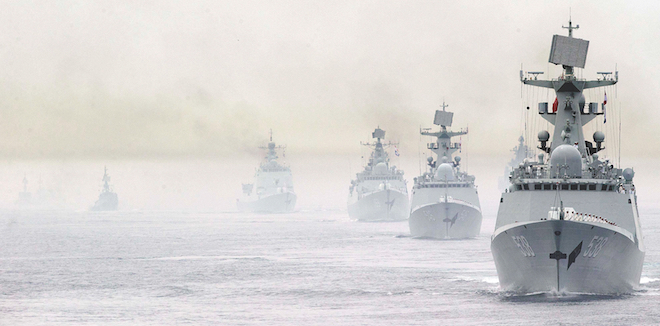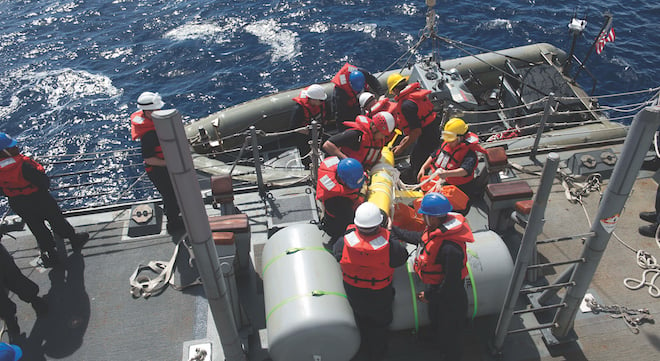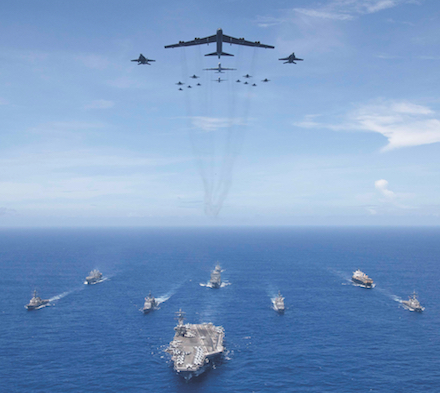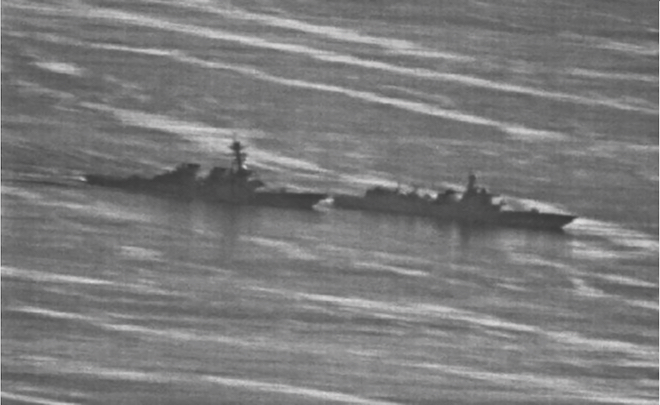
The rise of the Chinese Navy and the return of the Russian Navy have created serious challenges to U.S. command of the sea. (Associated Press)
The ability to move merchants and armies through the sea at will—and to prevent an opponent from moving theirs—typically is referred to as “command of the sea.” The United States’ decades-long command of the sea has enabled both rapid response to threats that arise in any part of the world and secure commerce that has grown the global economy. Even competitor nations have benefited from the relatively peaceful waters guaranteed by U.S. sea power.
In the 27 years since the fall of the Soviet Union, however, the global picture has changed. Rising economic powers developed their navies, defunct regimes transferred complex munitions to nonstate organizations, and near-instantaneous information exchange connected ideological demagogues with their sleeping armies. Nowhere is the global shift more evident than on the sea. The maritime commons increasingly are crowded and dangerous and beg an analysis of whether the United States still commands the sea.
Command of the Sea
Command of the sea is a two-part condition made up of global naval influence and local sea control.1 Global naval influence in today’s world means having the global logistics and long-range warfare capability to provide a credible threat of offensive naval power (or deterrence) anywhere in the world. Local sea control means having the platforms and weapons—whether manned or unmanned, offensive or defensive, sea-based or land-based—to regulate access to a localized sea area.

The United States does not have enough ships to maintain local control of the sea commons. In 2016, the People’s Liberation Army Navy unlawfully seized a U.S. Navy unmanned underwater vehicle in the South China Sea, shown here being returned to the United States at sea. (U.S. Navy/Joshua Mortensen)
The combination of global influence and local control allows a state to move commerce and military forces across the oceans, overcome challenges to its movement and interests, and block the movement and interests of its adversaries. While the means used to achieve global naval influence or local sea control may change over time, these two components are the indivisible metrics of command of the sea.
The United States has an unrivaled ability to move, supply, and sustain commerce and armies across the oceans, and it can marshal its capable fleet to block the movement and interests of most of its adversaries during conflict. It also retains the ability to perform hemispheric homeland defense against seaborne invasion and the post–World War II requirement of strategic nuclear deterrence. However, in maritime commons crowded by capable adversaries, U.S. movement and interests can be blocked.
Unlike other navies in history, which have weathered limited challenges, the United States faces risks to its sea control in several vital areas across the globe. Although the United States mounts an array of non-military efforts to supplement its naval action, threats mutate, weapons proliferate, and command of the sea remains primarily a naval enterprise.
Simply put, there are not enough ships in the U.S. Navy to overcome all worldwide threats to sea control. Despite naval efforts to modernize and restructure, the United States relies on luck or good fortune to ensure that half a dozen legitimate challenges do not develop at once. If they did, it would rely on non-naval forms of national power to cope, because neither the Navy nor any other fleet on the planet could simultaneously defeat all the global threats to local sea control.
The U.S. Navy thus is dethroned: Its tenuous hold on local sea control unseats its command of the sea.
An Uncommanded Sea
Although it has not been explicit, the Navy slowly has acknowledged its inability to command the sea alone. The first hint came in 2005 at the International Seapower Symposium, when Vice Admiral Mike Mullen introduced the “1,000-ship Navy”—a fleet-in-being comprising the U.S. and other navies partnering to improve maritime security. In the years since, other naval leaders have followed suit, advancing a collective or corporate command of the sea.2 However, collective command may not be possible, and regional partners have resisted the concept.

Although the United States mounts an array of non-military efforts to supplement its naval action, threats mutate, weapons proliferate, and command of the sea remains primarily a naval enterprise. Simply put, there are not enough ships in the U.S. Navy to overcome all worldwide threats to sea control. (U.S. Navy)
The Navy recently shifted its focus from command of the sea to local sea control. In 2015, Admiral Thomas Rowden introduced distributed lethality, a concept he deemed “the motive force behind offensive sea control.” He made the focus of the 2016 Surface Warfare Flag Officer Training Symposium a “Return to Sea Control,” and said in 2017 that while command of the sea is a useful term for historical analyses, it is “less useful in modern parlance.”3
While many naval thinkers have dispensed with the idea that the United States must command the sea to protect its interests, neither the United States nor its Navy has explained how a navy without command of the sea can defend a sea-based system of global trade and stability. Quite the opposite. Maritime strategies since 2005 have detailed the importance of the global system and argued that global prosperity, maritime security, and the U.S. Navy are inextricably linked.
The Navy must either regain command of the sea or institutionalize the loss. In either case, it must arm itself with the language and education to discuss that decision and align its acquisitions with an executable strategy. Thinking beyond technical solutions to strategic problems might help the United States avoid becoming a prisoner of its overly technological way of war, allowing instead U.S. values and creativity to drive U.S. choices.
Naval Doctrine and Education
At such a drastic time of change, how the Navy thinks, talks, and teaches are important. While most military thinkers are convinced the Third Offset Strategy involves ultra-technologies, history suggests that when an adversary is not clearly defined or is rapidly evolving, the game-changing force is a well-indoctrinated officer class. Steeped in naval history, strategic thinking, mental resilience, creativity, autonomy, and the ground-truth capabilities and tactics of their adversaries, naval leaders can win battles and influence national policy.
Doctrine provides both the room for lengthy discussions of naval theory and philosophy and the requirement that they be understood. It is more resistant to short-lived ideas than other sources of knowledge such as course curricula, the Navy Professional Reading Program, or warfare conferences. And when it fails to resist incomplete or flawed notions, doctrine can provide a roadmap of how the Navy got to where it is as an institution.4
Of course, ideas evolve—and naval learning institutions should cater to that. In addition to bolstering the curriculum at the Naval War College and revamping surface warfare officer training, the Navy should begin complex officer education earlier. Accession pipelines should provide midshipmen in the Sea Power & Maritime Affairs course a sophisticated understanding of the doctrine and strategy informing this generation of naval thinking, not just the naval history survey that most receive. Chief of Naval Operations Admiral John Richardson’s recent initiative to include great power competition in accession training is perfectly timed.
The United States is overdue for linguistically accurate and historically informed strategic conversations. Syncing the language and education of all involved—those who will execute operations, debate financial implications, develop strategy and tactics, and make national decisions—ensures that all in the force are of one mind and one fight.
Naval Strategy and Acquisitions
Although the tendency to see technical solutions to nontechnical problems is not unique to the U.S. Navy, it often results in an inversion of the proper relationship between maritime strategy and acquisitions. Too often, technological limitations drive shortsighted strategy: The United States decides what it wants to accomplish strategically based on what it can accomplish technically.5 The Navy can get ahead of this—because good strategy, like good doctrine, stands the test of time.
First, the Navy must decide whether command of the sea is a useful tool or a strategic objective—a means or an end—to determine how to invest in its future. Consider the trade-off between aircraft carriers and partner networking. Because of disparate technologies and hardware systems, unsecure communications at risk of exploitation, and overly classified information, the United States is only marginally able to leverage the ships and sailors of partner navies.6 From a fiscal standpoint, removing just one aircraft carrier from the Navy’s shipbuilding plans and diverting the funds to provide networking solutions for allies could address the problem holistically. Far from a drastic decision divorced from the growing threats of the seas, this solution could enable one version of U.S. strategy resulting from a sophisticated understanding of command of the sea.
Well-informed strategy also provides freedom and direction to the U.S. research and development community. If the Navy unleashed its creative and intellectual capacity, it might discover that command of the sea will not always require large numbers of ships floating on the water. Rather than ask how many and what types of ships it should build, the Navy could ask its leading thinkers what other means it might use to achieve global influence or exert local control.
By returning technology to its rightful place subordinate to strategy, the Navy could leverage its acquisitions for true solutions rather than superficial changes. The congressional commission of three independent studies to assess fleet architecture was a step in the right direction.7 In these three reports the Navy has a sober assessment of its largesse and a justification to look beyond ships and missiles for answers.
U.S. National Power and Grand Strategy
In addition to influencing maritime strategy and naval acquisitions, U.S. loss of command of the sea should inform U.S. academic and political discourse. There is in academia and government a conflation of the idea of national power with command of the sea.

In the period since the Cold War, adversary navies have been growing, both in size and boldness. In September 2018, the USS Decatur (DDG-73) (left) had to maneuver to avoid colliding with a Chinese destroyer during a confrontation in the South China Sea. (U.S. Navy)
The prevailing logic is that from national power (specifically military and economic power) flows sea power, and from predominant sea power comes command of the sea.8 This mental model seems logical on its surface and makes for drawing simple conclusions: The most resilient, diverse economy in the world funds the biggest, most powerful military in the world, and the resulting navy is in charge of the oceans. As long as the United States is the sole superpower, its Navy retains the ability to go where it needs to go and do what it wants to do. Command of the sea then flows from exceptional national power and, by enabling freedom of movement in the pursuit of national interests, also reinforces it.
Having the most resilient economy in the modern world and the most powerful Navy in history result in significant sea power, but they do not automatically confer on the United States command of the sea. Command of the sea results from the combination of global naval influence—which the United States has—and the ability to exert local sea control in all the sea commons—which it does not. Inserting these two factors into the model, one sees how even preeminent and exquisite military and economic power cannot guarantee command of the sea.
The loss of command of the sea does not mean the United States is in decline or must demur to growing powers or nonstate actors. Rather, it means an effective strategy must consider the agency of other actors in the field and how best to prevail in their presence. Most important, the lessons of the maritime commons extend to the rest of our shared spaces. Barry R. Posen has pointed out, “Without command of the commons, there is no hegemonic strategy of any kind that is possible.”9
As the director of the Institute for National Strategic Studies has written, “There should never be doubt that when core interests are engaged, the United States will bring the full weight of its power to bear and will persist until success is achieved.”10 In today’s world, U.S. power may have more to do with narrowly defining core interests than with exerting influence everywhere at all times. Fulfilling the role of leader rather than hegemon, the United States likely will find more money, more friends, and more options.
The Navy can lead the nation as it shifts focus to global leadership rather than pursuing an endless quest to outnumber adversaries. Other nations and navies will convert resources to power and earn a seat at the table. When they do, the navy that is doctrinally, institutionally, and strategically prepared will prevail.
The U.S. Navy remains the world’s most capable ally and its most dangerous enemy—and that is a position we can protect.
1. This assertion follows a literature review of both classic and modern naval thinkers including Alfred Thayer Mahan and Julian Corbett, Bernard Brodie, Robert Rubel and Milan Vego, Benjamin “BJ” Armstrong, and John Kuehn.
2. Naval Doctrine Publication 1 (March 2010): 28. “Twenty-First International Seapower Symposium Report on the Proceedings 16–19 September 2014,” ed. John B. Hattendorf and John Kennedy (Newport, RI: U.S. Naval War College, February 2015).
3. VADM Thomas Rowden, USN, “Distributed Lethality,” U.S. Naval Institute Proceedings 141, no. 1 (January 2015), and “Commentary–Sea Control First,” U.S. Naval Institute Proceedings 143, no. 1 (January 2017).
4. Doctrine is a subcategory of military literature that is distinguished by two characteristics: its approval by an authority, typically the government; and its mandated use by that authority. Walter E. Kretchik, U.S. Army Doctrine: From the American Revolution to the War on Terror (Lawrence: Kansas University Press, 2011), 5.
5. The Navy’s last major shift in strategy was made possible by Admiral Mike Mullen’s refusal to talk resources in the early idea stages of strategy-making. Peter Haynes, Toward a New Maritime Strategy: American Naval Thinking in the Post-Cold War Era (Annapolis, MD: Naval Institute Press, 2015), 217.
6. Stephanie Hszieh, George Galdorisi, Terry McKearney, and Darren Sutton, “Networking the Global Maritime Partnership,” Naval War College Review 65, no. 2 (Autumn 2012): 11. See also Center for Strategic and Budgetary Assessments, “Alternative Future Fleet Architecture Study,” September 2016.
7. Office of the Chief of Naval Operations (N8), “Alternative Future Fleet Platform Architecture Study,” July 2016. Mitre Corporation, “Navy Future Fleet Platform Architecture Study,” 1 July 2016. Center for Strategic and Budgetary Assessments, “Alternative Future Fleet Architecture Study,” September 2016.
8. See William Wohlforth, “The Stability of a Unipolar World,” International Security 24, no. 1 (Summer 1999): 5–41; and Stephen Brooks and William C. Wohlforth, America Abroad: The United States’ Global Role in the 21st Century, (Oxford, England: Oxford University Press, 2016), 14–47.
9. Barry Posen, Texas A&M Bush School Grand Strategy Conference, 30 November 2016.
10. Richard D. Hooker Jr., The Grand Strategy of the United States: INSS Strategic Monograph (Washington, DC: National Defense University Press, October 2014), 26.
Lieutenant Commander Riehl (formerly Edwards) is a P-3 pilot and former Art of War Scholar in Residence at the U.S. Army Command and General Staff College. She currently is transitioning to her department head tour flying the T-45 with VT-7 at Naval Air Station Meridian, Mississippi.


